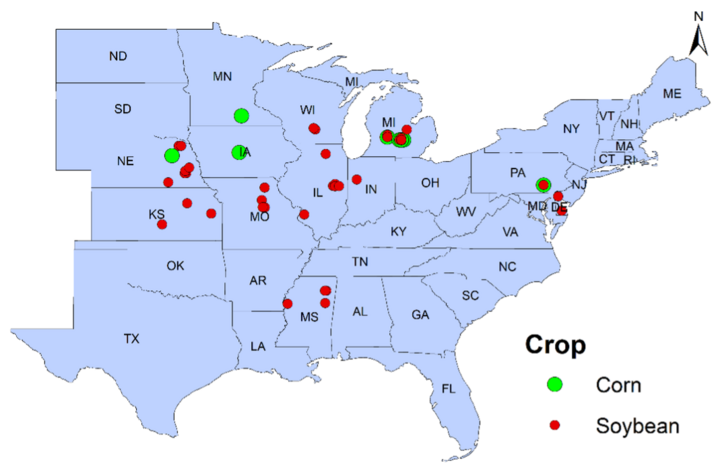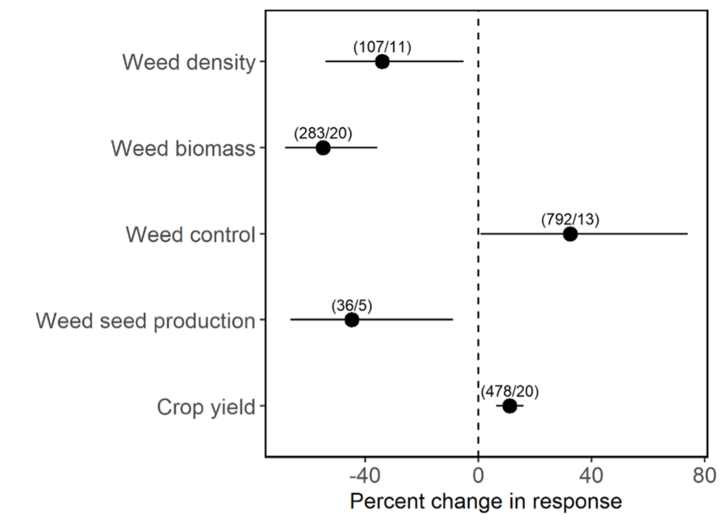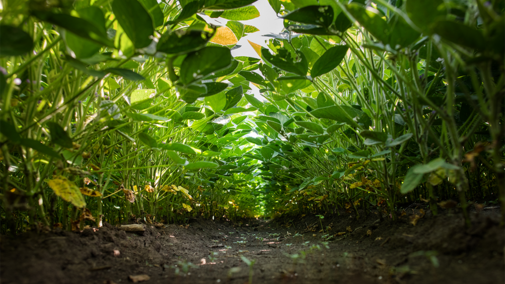Narrow row spacing holds the potential to help suppress weeds and increase crop yield. Over the past two decades, there has been a growing interest in row spacing narrower than 30 inches, particularly in soybean. For instance, in Nebraska, the average row width of soybean decreased from 28.5 inches in 1993 to 24.0 inches in 2003 and 24.2 inches in 2023 (USDA NASS 1993, 2003, 2023). For corn, while the average row spacing in Nebraska remained relatively stable (33.4 inches in 1993, 32.2 inches in 2003, and 30.8 inches in 2023), there has been a shift in its distribution. The percentage of corn rows that are 30.5 inches or less has increased from 34.5% in 1993 to 52.6% in 2003 and 68.3% in 2023 (USDA NASS 1993, 2003, 2023).
Many studies in the United States have researched the potential of narrow rows (Singh et al. 2023). Meta-analysis is a statistical technique to compile and analyze results from multiple independent studies to provide more reliable and comprehensive conclusions on any specific research topic or question. Studies fulfilling the following pre-determined criterion were included in the meta-analysis:
- Corn or soybean field study from the United States.
- Row spacing treatments of 30 inches (control) and under (
- Have reported means of control (30 inches) and row spacing treatments (
A total of 35 studies conducted between 1961 and 2018 fitted this criterion. We compiled 1,904 pair-wise observations from these relevant studies. Most studies investigated soybean (n = 27 out of 35) and were conducted in the midwestern United States (Figure 1; n = 29 out of 35).

What Did We Find?
- Row spacing less than 30 inches suppressed weed density and biomass by ≥34% and weed seed production by 45%, while increasing weed control by 32% and crop yield by 11% compared with 30-inch rows (Figure 2).
- The benefits of narrow rows were observed in soybean but not in corn. In soybean, less than 30-inch row spacing suppressed weed density and biomass by ≥42% and improved yield by 12% compared with 30-inch row spacing.
- Crop yield was not improved in weed-free plots and had the most significant increase when plots were untreated. This indicates that crop yield was partially enhanced due to the weed suppression effect of narrow row spacing, among other factors.
- Greater suppression in weed biomass and weed seed production was observed when sequential application of herbicides was used instead of single application in addition to narrow rows.

What Were the Results of Studies Conducted in Nebraska?
- Seven studies were conducted in Nebraska that were included in the meta-analysis (Burnside 1979; Burnside and Colville 1964; Hock et al. 2005, 2006; Knezevic et al. 2003; McDonald et al. 2021; Moomaw and Martin 1984). All studies included soybean except one with corn (Moomaw and Martin 1984).
- The earliest study was conducted in 1961 and 1962 in Lincoln, where researchers evaluated the effects of row spacing, tillage, irrigation, and pre-emergence applications of 3-amino-2,5-di-chlorobenzoic acid (amiben) on weed suppression and soybean yield (Burnside and Colville 1964). The soybean was planted at a 90 lb/ac seeding rate in 10-, 20-, 30- and 40-inch rows. Researchers reported an average weed biomass reduction of 39% in 10- and 20-inch (170 lb/ac) soybean rows compared with 30-inch rows (280 lb/ac). The likely reason for weed suppression was early canopy closure in narrow rows. In 1962, soybean in 10- and 20-inch rows shaded the ground completely 22 and 11 days before soybean in the 30-inch rows (58 days after planting), respectively. They also reported an average yield increase of 32% in 10-inch rows (41.4 bu/ac) and 11% in 20-inch rows (35.0 bu/ac) compared with 30-inch rows (31.4 bu/ac).
- Another study was conducted in Lincoln from 1973 to 1975 where two soybean varieties were planted in 15- and 30-inch rows under non-irrigated conditions (Burnside 1979). Weeds were either not removed or removed at weekly intervals of 0-2, 2-3, 2-4, 2-5, 2-6, 2-9, 4-9, and 6-9 weeks after soybean planting. When weeds were not removed, average weed biomass was slightly lower in 15-inch (2,226 lb/ac) compared with 30-inch rows (2,329 lb/ac). As a result, soybean yield was somewhat higher in 15-inch (12 bu/ac) than 30-inch (11 bu/ac) rows, but the difference was statistically similar.
- One study addressing the critical time for weed removal was conducted from 1999 to 2001 at Eastern Nebraska Research, Extension and Education Center near Mead, and in 2000 and 2001 at the Haskell Agricultural Laboratory near Concord (Knezevic et al. 2003). The soybean was planted at 168,000 seeds/ac in 7.5-, 15-, and 30-inch rows. The critical time of weed removal was consistently delayed with the narrowing of rows in all site years; it occurred at the first trifoliate stage for 30-inch row spacing, at the second trifoliate stage for 15-inch row spacing, and at the third trifoliate stage for 7.5-inch row spacing. Therefore, soybean planted in wider rows required weed management early in the season due to reduced early-season crop tolerance to weeds. This study reported lower soybean yields with increased row spacing in season-long weedy conditions in four out of five site years. Still, yield response to row spacing was generally inconsistent under season-long weed-free conditions, indicating that soybean yield increase in 7.5-inch rows was probably due to improved crop competitiveness against weeds.
- Two studies were conducted in 2002 and 2003 in northeastern Nebraska at the Haskell Agricultural Laboratory near Concord, and in 2003 at the University of Nebraska Agricultural Research Farm in Lincoln (Hock et al. 2005, 2006). The soybean was planted at 163,000 to 164,000 seeds/ac in 7.5- and 30-inch rows. Ten common weed species were seeded three times at soybean planting, emergence and the first trifoliate leaf stage. In general, lower leaf area and biomass were produced by most weed species in 7.5-inch rows compared with 30-inch rows. For example, averaged across the time of emergence, velvetleaf produced 40% lower leaf area (1,113 vs. 1,870 cm2/plant), and sunflower produced 27% lower biomass (275 vs. 375 g/plant) in 7.5-inch rows compared with 30-inch rows. This generally corresponded to lower soybean yield loss in 7.5-inch than 30-inch rows; however, some weed species, such as common cocklebur and giant ragweed, caused similar yield loss in both row spacing.
- The most recent study was conducted in 2018 and 2019 in a grower’s field near Carleton, Nebraska, to assess the effect of row spacing and herbicide programs for managing glyphosate-resistant Palmer amaranth in XtendFlex (dicamba/glufosinate/glyphosate-resistant) soybean (McDonald et al. 2021). The soybean was planted at 140,000 seeds/ac in 15- and 30-inch rows under rainfed conditions. Fourteen herbicide programs were evaluated: two early-POST, four early-POST fb late-POST, four PRE fb early-POST, and four PRE fb early-POST plus a residual herbicide. PRE fb early-POST programs, including residual herbicide, were the most effective in controlling Palmer amaranth. However, control was mostly similar across the row spacings. Averaged across herbicide programs, the lower density of Palmer amaranth was reported under 15 inches (4,047 plants/ac) than 30 inches (60,702 plants/ac) row spacing, resulting in a 15% increase in soybean yield under 15 inches (27 bu/ac) than 30 inches (23 bu/ac) row spacing in one year in 2019.
Take Home Messages
- Row spacing less than 30 inches (such as 20 or 15 inches) could be integrated with herbicides to help suppress herbicide-resistant weeds that may provide a yield advantage in soybean.
- Results of the meta-analysis and studies conducted in Nebraska suggest that narrow rows (Sclerotinia stem rot, planting time, relative time of weed emergence, seeding rate, and soil moisture availability, etc. that need to be considered for deciding to adopt narrow rows at farm-level.
- For corn, narrow row spacing did not lead to weed suppression or yield advantage across the limited studies included in this meta-analysis.
To get more information on this topic, read this reference:
Singh M, Thapa R, Singh N, Mirsky SB, Acharya BS, Jhala AJ (2023) Does narrow row spacing suppress weeds and increase yields in corn and soybean? A meta-analysis. Weed Sci 71:520-535 Download PDF
References
Burnside OC (1979) Soybean (Glycine max) growth as affected by weed removal, cultivar, and row spacing. Weed Sci 27:562–565
Burnside OC, Colville WL (1964) Soybean and weed yields as affected by irrigation, row spacing, tillage, and amiben. Weeds 12:109–112
Hock SM, Knezevic SZ, Martin AR, Lindquist JL (2005) Influence of soybean row width and velvetleaf emergence time on velvetleaf (Abutilon theophrasti). Weed Sci 53:160–165
Hock SM, Knezevic SZ, Martin AR, Lindquist JL (2006) Soybean row spacing and weed emergence time influence weed competitiveness and competitive indices. Weed Sci 54:38–46
Knezevic SZ, Evans SP, Mainz M (2003) Row spacing influences the critical timing for weed removal in soybean (Glycine max). Weed Technol 17:666–673
McDonald ST, Striegel A, Chahal PS, Jha P, Rees JM, Proctor CA, Jhala AJ (2021) Effect of row spacing and herbicide programs for control of glyphosate-resistant Palmer amaranth (Amaranthus palmeri) in dicamba/glyphosate-resistant soybean. Weed Technol 35:790-801
Moomaw RS, Martin AR (1984) Cultural practices affecting season-long weed control in irrigated corn (Zea mays). Weed Sci 32:460–467
[USDA-NASS] U.S. Department of Agriculture‒National Agricultural Statistics Service (1993) Crop Production. https://downloads.usda.library.cornell.edu/usda-esmis/files/tm70mv177/fq977v58k/b5644s408/CropProd-11-09-1993.pdf Accessed: Aug. 28, 2024
[USDA‒NASS] U.S. Department of Agriculture‒National Agricultural Statistics Service (2003) Crop Production. https://downloads.usda.library.cornell.edu/usda-esmis/files/tm70mv177/p5547s355/6m311p98k/CropProd-11-12-2003.pdf Accessed: Aug. 28, 2024
[USDA‒NASS] U.S. Department of Agriculture‒National Agricultural Statistics Service (2023) Crop Production. https://downloads.usda.library.cornell.edu/usda-esmis/files/tm70mv177/5x21w011c/9306vh649/crop1123.pdf Accessed: Aug. 28, 2024

